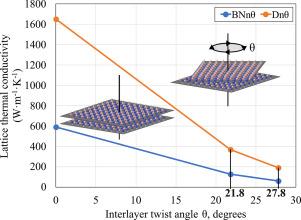Tuning thermal conductivity and electron–phonon interactions in carbon and boron nitride Moiré diamanes via twist angle manipulation
IF 6.9
2区 材料科学
Q2 CHEMISTRY, PHYSICAL
引用次数: 0
Abstract
We have investigated the effect of interlayer twist angle on lattice thermal conductivity (LTC) and band gap renormalization in boron nitride and carbon Moiré diamanes. Moment tensor potentials were used for calculating energies and forces of interatomic interactions. The methods based on the solution of Boltzmann transport equation (BTE) for phonons and the Green-Kubo (GK) formula were utilized to calculate LTC. The 20%–40% difference in LTC values obtained with GK and BTE-based methods showed the importance of high-order anharmonic contributions to LTC. Significant reduction (by 4.5–9 times) of the in-plane LTC with the twist angle increase caused by the growth of structural disorder was observed in the Moiré diamanes. This growth of disorder also leads to higher band gap renormalization (induced by classical nuclei motion) in the structures with higher twist angles. Significant band gap renormalization values obtained considering the quantum nuclear effects are caused by the high phonon frequencies related to the bonds with hydrogen atoms on the Moiré diamanes surfaces. Understanding of the twist angle effect on LTC and electron–phonon coupling in the Moiré diamanes provides a fundamental basis for manipulating their thermal and electronic properties, making these materials promising for thermoelectrics, microelectronics and optoelectronics.

通过扭转角调节碳和氮化硼硅橡胶中的导热性和电子-声子相互作用
研究了层间扭转角对氮化硼和碳偶氮金刚石晶格热导率和带隙重整化的影响。矩张量势用于计算原子间相互作用的能量和力。采用基于声子的玻尔兹曼输运方程(BTE)解和Green-Kubo (GK)公式的方法计算LTC。基于GK和基于bte的方法获得的LTC值相差20%-40%,这表明高阶非调和贡献对LTC的重要性。在moir金刚石中,由于结构无序性的增长,随着扭曲角的增加,面内LTC显著降低(4.5-9倍)。这种无序性的增长也导致高扭角结构中更高的带隙重整化(由经典原子核运动引起)。考虑量子核效应的带隙重整值的显著性是由莫尔奈金刚石表面与氢原子键相关的高声子频率引起的。了解扭曲角对摩尔烷中LTC和电子-声子耦合的影响,为控制其热学和电子性能提供了基础,使这些材料在热电、微电子和光电子领域具有广阔的应用前景。
本文章由计算机程序翻译,如有差异,请以英文原文为准。
求助全文
约1分钟内获得全文
求助全文
来源期刊

Applied Surface Science
工程技术-材料科学:膜
CiteScore
12.50
自引率
7.50%
发文量
3393
审稿时长
67 days
期刊介绍:
Applied Surface Science covers topics contributing to a better understanding of surfaces, interfaces, nanostructures and their applications. The journal is concerned with scientific research on the atomic and molecular level of material properties determined with specific surface analytical techniques and/or computational methods, as well as the processing of such structures.
 求助内容:
求助内容: 应助结果提醒方式:
应助结果提醒方式:


